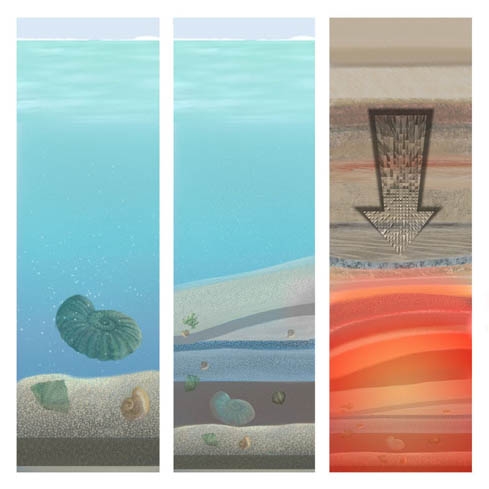The coordinates take you to the steps of the Cathedral of St. John the Baptist, one of two Cathedrals located in the City of Norwich.
When you come to the coordinates, take a look on the ground, look at the steps. If you look closely you can notice that there are hundreds of small fossils embedded in the steps.
These fossils are embedded in a stone called "Frosterley Marble" which has been used throughout the Church and shows a variety of fossilised creatures. However, even though it is called "Marble" it is in fact, a dark type of limestone that is quarried from mines near Frosterley, a village in County Durham. Once cut, turned and polished, its shiny black surface is highly decorative.
Frosterley Marble is a very fine-grained sedimentary rock, and is not a true marble in the geological sense. It can be cut and inlaid with other decorative stones and minerals, using a technique known as pietra dura.

Limestone (such as the type found here) is mostly formed from calcite. Calcite is a form of Calcium Carbonate, which has the chemical formula CaCO3. Calcium Carbonate is the same material that produces the "fur" on the inside of the kettle. Calcium Carbonate is removed from the seawater by the animals as they grow. When the animals die, their skeletons accumulate on the sea floor and are later turned to rock by a process known as lithification. (see above picture)
Limestone is an important rock type. It is widespread and often contains beautifully preserved fossils, but is also economically important. Limestone has been used as a fertilizer for heavy clay soils, as a flux for iron and steel making, and for making cement and concrete.
If you go inside the cathedral you can see many more excellent examples of the highly polished limestone inside that show off the fossils even more.
To claim this earth cache you must do the following
A) Measure the length and width of one fossil type embedded in the stone.
B) Describe the shape and detail of the fossil.
C) Try and identify the fossil and tell me whether the fossil may be coral, cephalopod or crinoid
D) Take a photo with with you and your GPS on the steps and post this image on the cache log (Optional but encouraged)
Please send your answers to me via my profile.

